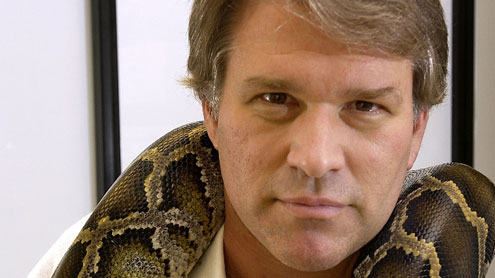Research into the extreme growth of Burmese python hearts during digestion may be the foundation for new human heart disease treatments, according to a recent Science Magazine article co-authored by University of Alabama scientist Stephen Secor.
Secor, an associate professor of biological sciences at UA, said understanding of the python heart research begins with understanding of the human heart.
There are two types of heart growth, or cardiac hypertrophy, that mammals can experience.
“Pathological hypertrophy refers to the diseased heart, which is the condition you’ll see with cardiac disease,” he said. “The heart must get bigger to pump the same amount of blood through a clogged artery. Physiological hypertrophy, or athlete’s heart, is when the heart grows to transfer more blood to active tissues.”
Secor said physiological hypertrophy, true to its nickname, is often found in athletes who engage in long-distance activities, such as runners and cyclists. As the athlete’s heart grows, its chambers do as well.
In a diseased heart, the heart has grown, but the walls are thicker and the channels smaller.
Burmese pythons experience a metabolic phenomenon after meals, as they will eat up to a fourth of their body weight at one time and can take up to five days to fully digest it.
Secor said the snakes’ metabolic rate would increase by 10 to 15 percent as their body works to break down the food.
According to the article published in Science, the python heart grows in mass by 40 percent within two to three days after a meal.
“The heart is operating in terms of growth like an athlete’s heart – it’s getting more blood to the tissues that are digesting the food,” Secor said. “But humans can barely increase their rate 5 percent, and they can’t maintain it for long.”
Secor first published his findings of python heart growth in 1995 while working at UCLA. He then said he wanted to study the mechanics and what could be signaling such a dramatic growth.
Secor, in collaboration with researchers at the University of Colorado, began to break down and isolate what was causing the growth.
In subsequent research and experiments, the team identified three fatty acids that appeared to trigger the extreme growth.
To test their findings, the researchers extracted the fatty acids present in digesting pythons and infused them into snakes that had not been fed. The fasting pythons experienced identical heart growth, despite not actually working to digest any food.
Secor is considering researching how generalized this response is.
“Can we get these responses in other pythons, other species of snakes?” he said. “The Burmese python is the only one that has been identified independently with this cardiac hypertrophy.”
Secor works with a research lab of three graduate students and eight undergraduates. In a room adjacent to his office in the biology building, Secor maintains two Burmese pythons, king snakes, corn snakes, legless lizards, scorpions and tarantulas. An alligator named Carlos and Fred the Gila monster also call Secor’s lab home.
Jonathan Belanich, a sophomore research assistant in the lab, said the experience is a lot different than working in your typical research lab.
“Its different because we have to take more precautions to make sure they don’t die and are well cared for,” Belanich said. “Plus, it’s more fun. We can take out a python or lizard and play with it, more so than a microbiologist can play with a bacterium.”
Despite finishing his most recent research, it is unlikely that Secor will lose interest in the animals any time soon.
“There is more cool stuff these snakes are doing. You can look at them and just think, yeah that’s a snake – but there is so much going on under the surface,” he said. “Some of the stuff pythons do have never been seen in other animals. We can’t even explain of the phenomena that they are experiencing.”







